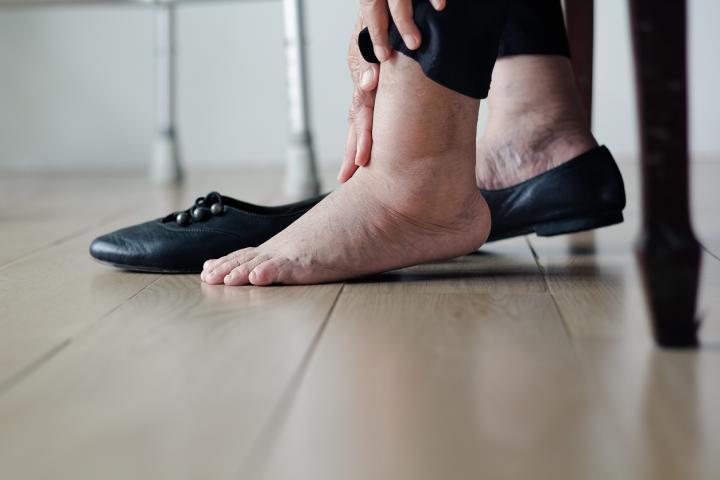Penn study implicates microbes in impaired wound healing that can lead to amputation

Credit: Penn Medicine
PHILADELPHIA – Whether a wound–such as a diabetic foot ulcer–heals or progresses to a worse outcome, including infection or even amputation, may depend on the microbiome within that wound. A new study from the Perelman School of Medicine at the University of Pennsylvania found specific strains of the common pathogen Staphylococcus aureus (S. aureus) are associated with wounds that do not heal. Researchers also identified other common bacteria in these wounds that can impair or even improve healing, suggesting that monitoring the microbes of diabetic foot ulcers could provide doctors with information on how best to treat these wounds. Cell Host and Microbe published the findings today.
About 10 percent of Americans have been diagnosed with diabetes, and one quarter of these patients will develop a wound that does not heal. In the worst case outcome, which occurs in up to 25 percent of these wound-developing patients, the wounds will require an amputation. Many patients who develop these ulcers may not notice the initial signs, since the high blood glucose of diabetes can lead to a lack of feeling and deformation of the feet. As a result, patients with diabetes commonly develop foot ulcers that may go unnoticed over time. Current treatments are insufficient, meaning patients can live with these wounds for months or even years without healing. The mortality rate associated with diabetic foot ulcers is equivalent to that of breast cancer and prostate cancer combined – higher than 70 percent when they lead to amputation.
“While wounds don’t receive the attention of other diseases, they’re incredibly common, and our study increases our understanding of how microbes impair or promote healing,” said the study’s senior author Elizabeth Grice, PhD, an associate professor of Dermatology. The lead author, Lindsay Kalan, PhD, now an assistant professor of Medical Microbiology and Immunology at the University of Wisconsin School of Medicine and Public Health, began this work as a post-doctoral researcher in Grice’s lab.
Previous studies have used lower resolution techniques to catalogue the microbes that reside in chronic wounds. This study built on that research by using higher resolution DNA sequencing to identify specific species and subspecies and how they are related to patient outcomes. Researchers collected samples from 46 patient ulcers every two weeks for six months, or until the wound healed or was amputated.
S. aureus, a common and difficult-to-treat pathogen, was found in the majority of wounds, but researchers note the presence of the bacteria itself did not predict whether or not a wound would heal. However, the high resolution DNA sequencing showed certain strains of S. aureus were only in the wounds that did not heal over the course of the study. Further testing revealed that the “non-healing” strain was better equipped to cause tissue damage and evade antibiotic treatments. Researchers further validated their findings in mice.
They also noted that another common microbe found in diabetic wounds, Alcaligenes faecalis, was associated with quicker healing.
“It is possible there are bacteria that actually benefit the wound, and we can use what we learned in this study to develop new treatment strategies for non-healing wounds,” Grice said. “We hope this research will eventually help identify patients at risk for bad outcomes and lead to treatment innovations that these patients desperately need.”
###
This study was supported by the National Institutes of Health through the National Institute of Nursing Research (R01-NR-009448, R01-NR-015639, P20 NR018081), the National Institute of Arthritis, Musculoskeletal, and Skin Disease (R01-AR-006663, R00-AR-060873), the Pennsylvania Department of Health, and the Linda Pechenik Montague Investigator Award.
Penn Medicine is one of the world’s leading academic medical centers, dedicated to the related missions of medical education, biomedical research, and excellence in patient care. Penn Medicine consists of the Raymond and Ruth Perelman School of Medicine at the University of Pennsylvania (founded in 1765 as the nation’s first medical school) and the University of Pennsylvania Health System, which together form a $7.8 billion enterprise.
The Perelman School of Medicine has been ranked among the top medical schools in the United States for more than 20 years, according to U.S. News & World Report’s survey of research-oriented medical schools. The School is consistently among the nation’s top recipients of funding from the National Institutes of Health, with $405 million awarded in the 2017 fiscal year.
The University of Pennsylvania Health System’s patient care facilities include: The Hospital of the University of Pennsylvania and Penn Presbyterian Medical Center — which are recognized as one of the nation’s top “Honor Roll” hospitals by U.S. News & World Report — Chester County Hospital; Lancaster General Health; Penn Medicine Princeton Health; Penn Wissahickon Hospice; and Pennsylvania Hospital — the nation’s first hospital, founded in 1751. Additional affiliated inpatient care facilities and services throughout the Philadelphia region include Good Shepherd Penn Partners, a partnership between Good Shepherd Rehabilitation Network and Penn Medicine, and Princeton House Behavioral Health, a leading provider of highly skilled and compassionate behavioral healthcare.
Penn Medicine is committed to improving lives and health through a variety of community-based programs and activities. In fiscal year 2017, Penn Medicine provided more than $500 million to benefit our community.
Media Contact
John Infanti
[email protected]




